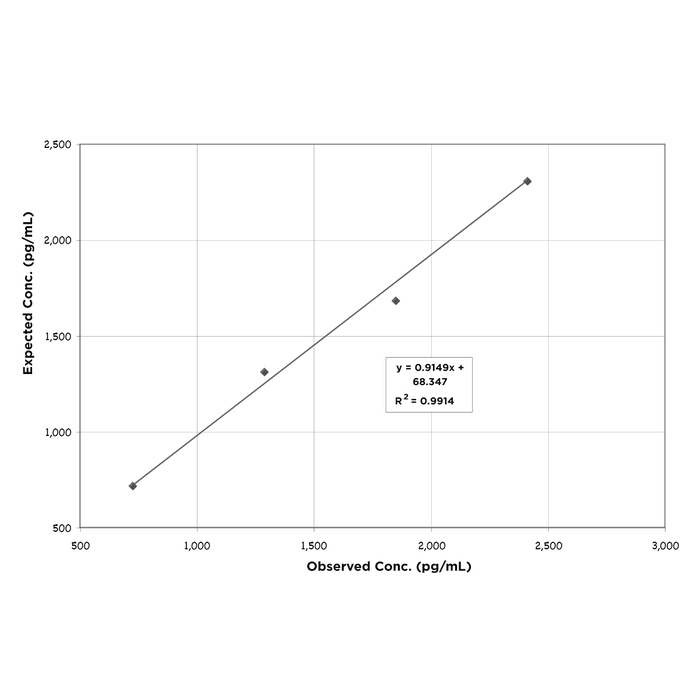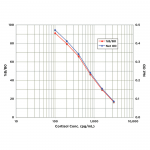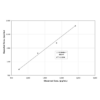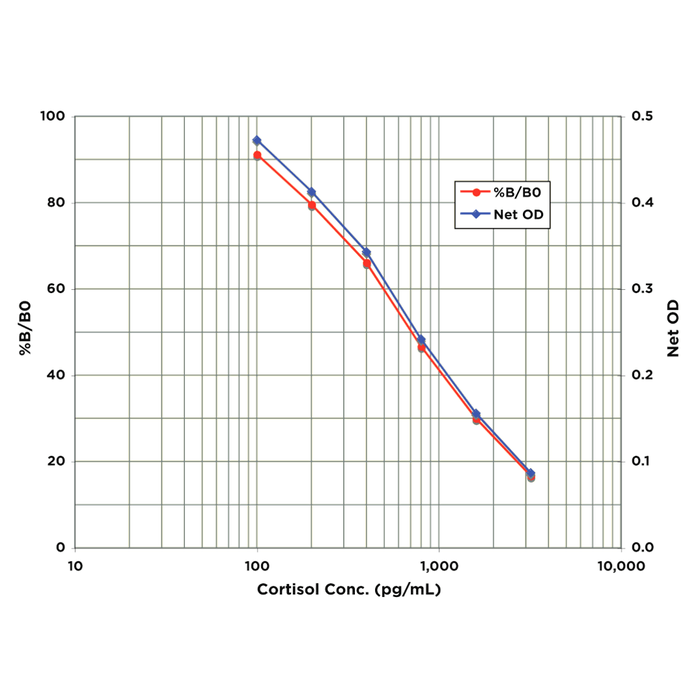| Product Name | Cortisol EIA Kit |
| Description |
Quantitative colorimetric detection of cortisol |
| Species Reactivity | Species Independent |
| Platform | Microplate |
| Sample Types | Dried Fecal Samples, EDTA Plasma, Heparin Plasma, Saliva, Serum, Tissue Culture Media, Urine |
| Detection Method | Colorimetric Assay |
| Assay Type | Competitive EIA (Enzyme Immune Assay) |
| Utility | EIA kit used to quantitatively measure cortisol present in samples. |
| Sensitivity | 30.3 pg/mL |
| Assay Range | 100 - 3200 pg/ml |
| Precision | Intra Assay Precision: Three human samples were diluted with Assay Buffer and run in replicates of 20 in an assay. The mean and precision of the calculated Cortisol concentrations were: Sample 1- 1174.3 pg/mL, 6% CV Sample 2- 475.9 pg/mL, 5.6% CV Sample 3- 177.4 pg/mL, 14.7% CV Inter Assay Precision: Three human samples were diluted with Assay Buffer and run in duplicates in ten assays run over multiple days by four operators. The mean and precision of the calculated Cortisol concentrations were: Sample 1- 1188.1 pg/mL, 7.2% CV Sample 2- 508.7 pg/mL, 6.3% CV Sample 3- 199.7 pg/mL, 10.9% CV |
| Incubation Time | 90 Minutes |
| Number of Samples | 40 samples in duplicate |
| Other Resources | Kit Booklet Lot. No. SC429429 , Kit Booklet Lot No. SC288128 , Kit Booklet Lot No SC187418 , Kit Booklet Lot No SC187760 , Kit Booklet Lot No SC587342 , MSDS , Steroid Solid Extraction Protocol , Saliva Sample Handling Instructions |
| Field of Use | Not for use in humans. Not for use in diagnostics or therapeutics. For in vitro research use only. |
Properties
| Storage Temperature | 4ºC and -20ºC | ||||||||||||||||||||||||||||||||||||
| Shipping Temperature | Blue Ice | ||||||||||||||||||||||||||||||||||||
| Product Type | EIA Kits | ||||||||||||||||||||||||||||||||||||
| Assay Overview | The Cortisol EIA kit is designed to quantitatively measure cortisol present in dried fecal extracts, saliva, urine, serum, plasma and tissue culture media samples. This kit measures total cortisol in extracted samples and in serum and plasma and free cortisol in saliva and urine. A cortisol standard is provided to generate a standard curve for the assay and all samples should be read off the standard curve. Standards or diluted samples are pipetted into a clear microtiter plate coated with an antibody to capture mouse antibodies. A cortisol-peroxidase conjugate is added to the standards and samples in the wells. The binding reaction is initiated by the addition of a monoclonal antibody to cortisol to each well. After an 1 hour incubation the plate is washed and substrate is added. The substrate reacts with the bound cortisol-peroxidase conjugate. After a short incubation, the reaction is stopped and the intensity of the generated color is detected in a microtiter plate reader capable of measuring 450 nm wavelength. The concentration of the cortisol in the sample is calculated, after making suitable correction for the dilution of the sample, using software available with most plate readers. | ||||||||||||||||||||||||||||||||||||
| Kit Overview |
|
||||||||||||||||||||||||||||||||||||
| Cite This Product | Cortisol EIA Kit (StressMarq Biosciences Inc., Victoria BC CANADA, Catalog # SKT-201) |
Biological Description
| Alternative Names | (11β)-11,17,21-trihydroxypregn-4-ene-3,20-dione |
| Research Areas | Cancer, Cell Signaling, Neuroscience, Oxidative Stress |
| Scientific Background |
Cortisol (C₂₁H₃₀O₅), also known as hydrocortisone, is the primary glucocorticoid hormone produced by the adrenal cortex in response to stress. Often referred to as the “stress hormone,” cortisol plays a central role in regulating blood pressure, glucose metabolism, immune responses, and circadian rhythms. Its secretion follows an ACTH-dependent diurnal pattern, peaking in the early morning and declining throughout the day. In neuroscience, cortisol is a key modulator of brain function. Chronic dysregulation of cortisol levels has been linked to cognitive decline, mood disorders, and neurodegenerative diseases such as Alzheimer’s and Parkinson’s. Elevated cortisol can impair hippocampal function, reduce neurogenesis, and contribute to neuronal atrophy. Only free cortisol, which constitutes about 4% of circulating levels, is biologically active and capable of binding to glucocorticoid receptors in the brain. Abnormal cortisol levels are associated with psychiatric and neurological conditions including depression, schizophrenia, and Cushing’s syndrome. |
| References |
1. E. Friess, et al., Eur J Clin Invest, 2000, 30, Suppl 3:46-50. 2. Freeman, Scott, 2002. Biological Science. Prentice Hall; 2nd Pkg edition (December 30, 2004). 3. C. Longscope., J. Endocrinology, 1996, , Suppl S125-S127. 4. J. Herbert, Lancet, 1995 345, 1193-1194. 5. A. Michael, et al., Biol. Psychiatry, 2000, 48, 989-95. 6. C.R. Dequet and D.J. Wallace, Current Opin. Ivest. Drugs, 2001, 8, 1045-53. 7. W.M. Jeffries, Med. Hypotheses, 1998, 51, 114-4. |
Product Images

Linearity was determined by taking two human urine samples diluted 1:140, one with a low diluted cortisol level of 163.9 pg/mL and one with a higher diluted level of 2,974.9 pg/mL and mixing them in the ratios given below. The measured concentrations were compared to the expected values based on the ratios used.




StressMarq Biosciences :
Based on validation through cited publications.